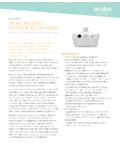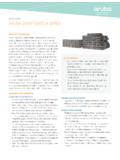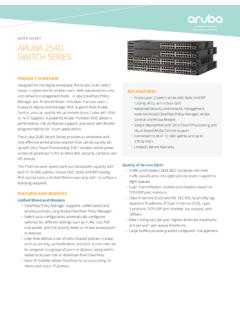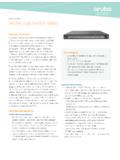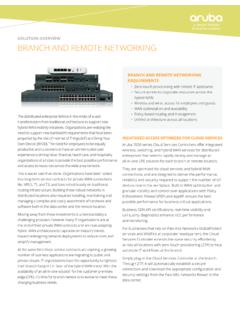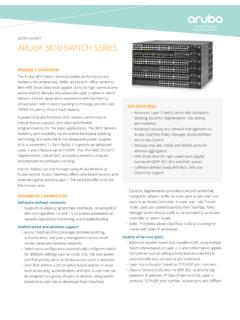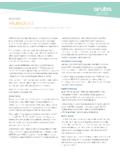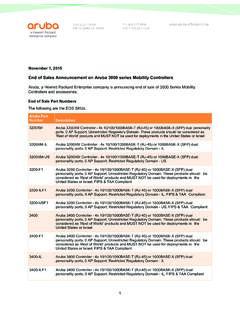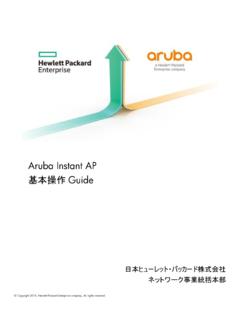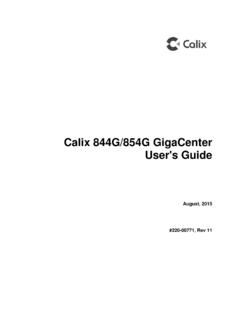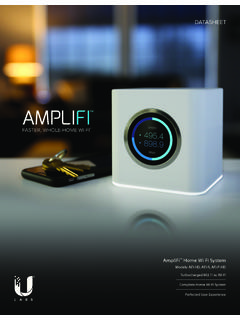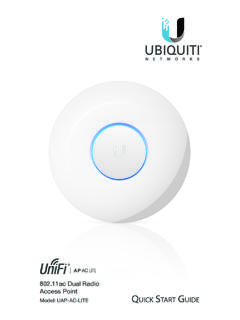Transcription of Aruba 340 Series Campus Access Points Data Sheet
1 DATA Sheet . Aruba 340 Series . Campus Access Points . Extreme performance Wave 2 APs with dual -5 GHz and multi-gig Ethernet support The Aruba 340 Series Access Points provide the fastest gigabit data speeds and superb user experience for mobile devices and applications in a digital workplace. Designed with an integrated, Compliant, HPE SmartRate multi-gig Ethernet port to eliminate wired bottlenecks, these APs offer unmatched wireless performance and capacity. The unique and flexible dual -5 GHz The 340 Series APs have an integrated Bluetooth Low- Energy (BLE) radio, which can be used as an Aruba beacon architecture of the 340 Series offers a way to double for advanced location, indoor wayfinding, and to enable 5 GHz capacity where needed, without compromise proximity-based push notification services.
2 The integrated or restrictions. beacon radio also enables the remote management of Thanks to Aruba 's advanced ClientMatch technology, the battery-powered and other standalone beacons in a large- 340 Series can automatically detect and classify scale network of Aruba beacons. It enables businesses to Wave 2 capable mobile devices. This allows ClientMatch to leverage mobility context to develop applications that can automatically group Wave 2 capable devices onto a single deliver an enhanced user experience and increase the value Wave 2 radio so that performance benefits of multi-user of the wireless network for organizations. MIMO can be realized without the adverse effects of slower and traditional capable mobile UNIQUE BENEFITS.
3 Devices. This means increased network capacity and a boost Unified AP deploy with or without controller in network efficiency. --The 340 Series APs can be deployed in either controller- based (ArubaOS) or controllerless (InstantOS). With maximum data rates of 2,166 Mbps in the 5 GHz band1. deployment mode and 800 Mbps in the GHz band (for an aggregate peak dual Radio 4x4 Access point with Multi-User data rate of Gbps in dual - band mode and Gbps in MIMO (wave 2). dual -5 GHz mode), the 340 Series APs deliver a best-in-class, --Supports up to 2,166 Mbps per radio in the 5 GHz band next-generation Wi-Fi infrastructure that is ideal for (with 4SS/VHT80 or 2SS/VHT160 clients) and up to 800. lecture halls, auditoriums, public venues, and high-density Mbps in the GHz band (with 4SS/VHT40 clients).
4 Office environments. --Antenna polarization diversity (fixed) for optimized These high performance and high density 340 Series RF performance Access Points support up to 160 MHz channel bandwidth (VHT160), and 4 spatial streams (4SS) for both SU- and MU-MIMO communications. 1. Initially, the 5 GHz radio will be limited to 1,733 Mbps. The proprietary extension (1024-QAM support) to enable MCS10 and MCS11 and rates up to 2,166 Mbps will be introduced in a later SW release. Please check SW release notes for this upgrade. With 1,733 Mbps, the aggregate peak numbers drop to Gbps ( dual -radio) and Gbps ( dual -5 GHz). DATA Sheet . Aruba 340 Series Campus Access Points . Optional dual -5 GHz mode supported, where the GHz Spectrum analysis radio is converted to a second 5 GHz radio --Capable of part-time or dedicated air monitoring, the --Both 5 GHz radios providing full coverage, doubling the spectrum analyzer remotely scans the GHz and performance and capacity 5 GHz radio bands to identify sources of RF interference --Unlike competitive solutions, the 340 Series is from HT20 through VHT160 operation designed to isolate the two 5 GHz transmitters for Aruba Secure Core higher performance --Device assurance: Use of Trusted Platform Module (TPM).
5 --Conversion can be manual/fixed, or automatic and for secure storage of credentials and keys as well as dynamic (software controlled, under-the hood), based on secure boot system-wide capacity and load in both bands --Integrated wireless intrusion protection2 offers threat HPE SmartRate uplink Ethernet port (E0) protection and mitigation, and eliminates the need for --Supports up to Gbps with NBase-T and IEEE separate RF sensors and security appliances Ethernet compatibility --IP reputation and security services identify, classify, --Backwards compatible with 100/1000 Base-T and block malicious files, URLs and IPs, providing Hitless PoE failover between both Ethernet ports comprehensive protection against advanced online threats Built-in Bluetooth Low-Energy (BLE) radio --SecureJack-capable for secure tunneling of wired --Enables location-based services with BLE-enabled mobile Ethernet traffic devices receiving signals from multiple Aruba Beacons at Intelligent Power Monitoring (IPM).
6 The same time --Enables the AP to continuously monitor and report --Enables asset tracking when used with Aruba Asset Tags its actual power consumption and optionally make Advanced Cellular Coexistence (ACC) autonomous decisions to disable certain capabilities --Minimizes interference from 3G/4G cellular networks, based on the amount of power available to the unit distributed antenna systems and commercial small --Software configurable to disable capabilities in certain cell/femtocell equipment orders. For the 340 Series Access Points , by default, the Quality of service for unified communications applications USB interface will be the first feature to turn off if the AP. --Supports priority handling and policy enforcement power consumption exceeds the available power budget for unified communication apps, including Skype for Business with encrypted videoconferencing, voice, chat CHOOSE YOUR OPERATING MODE.
7 And desktop sharing The Aruba 340 Series APs offer a choice of deployment and Aruba AppRF technology leverages deep packet inspection operating modes to meet your unique management and to classify and block, prioritize, or limit bandwidth for deployment requirements: thousands of applications in a range of categories The 340 Series AP is a unified AP that supports both Best-in-class RF Management controller-based and controller-less deployment modes, --Integrated AirMatch technology manages the providing maximum flexibility. and 5-GHz radio bands and actively optimizes the RF. Controller-based mode When deployed in conjunction environment including channel width, channel selection with an Aruba Mobility Controller, Aruba 340 Series APs and transmit power offer centralized configuration, data encryption, policy --Adaptive Radio Management (ARM) technology provides enforcement and network services, as well as distributed airtime fairness and ensures that APs stay clear of all and centralized traffic forwarding.
8 Sources of RF interference to deliver reliable, high- Controller-less (Instant) mode The controller function performance WLANs is virtualized in a cluster of APs in Instant mode. As the network grows and/or requirements change, Instant deployments can easily migrate to controller-based mode. Remote AP (RAP) mode for branch deployments 2. Not supported in dual -5 GHz mode Air monitor (AM)2 for wireless IDS, rogue detection and containment DATA Sheet . Aruba 340 Series Campus Access Points . Spectrum analyzer (SA)2, dedicated or hybrid, for Supported frequency bands (country-specific identifying sources of RF interference restrictions apply): Secure enterprise mesh portal or point to GHz to GHz3. For large installations across multiple sites, the Aruba to GHz3.
9 Activate service significantly reduces deployment time by to GHz4. automating device provisioning, firmware upgrades, and to GHz4. inventory management. With Aruba Activate, the Instant APs Available channels: Dependent on configured are factory-shipped to any site and configure themselves regulatory domain when powered up. Dynamic frequency selection (DFS) optimizes the use of available RF spectrum SPECIFICATIONS. Supported radio technologies: Hardware Variants : Direct-sequence spread-spectrum (DSSS). AP-344: External antenna models : Orthogonal frequency-division AP-345: Internal antenna models multiplexing (OFDM). Wi-Fi Radio Specifications Supported modulation types: AP type: Indoor, dual radio, 5 GHz 4x4 MIMO and : BPSK, QPSK, CCK.
10 GHz 4x4 MIMO : BPSK, QPSK, 16-QAM, 64-QAM, --The GHz radio supports all rates as well 256-QAM, 1024-QAM (proprietary extension). (proprietary extension) Transmit power: Configurable in increments of dBm Software-configurable dual radio supports: Maximum (aggregate, conducted total) transmit power -- dual -radio mode: 5 GHz (Radio 0) and GHz (Radio 1) (limited by local regulatory requirements): -- dual -5 GHz mode: upper 5 GHz (Radio 0) and lower 5 GHz band : +24 dBm (18dBm per chain)5. GHz (Radio 1) --5 GHz band : +24 dBm (18 dBm per chain)5. 5 GHz: --Note: Conducted transmit power levels exclude antenna --Four spatial stream Single User (SU) MIMO for up to gain. For total (EIRP) transmit power, add antenna gain. 1,733 Mbps wireless data rate to individual 4SS VHT80 Advanced Cellular Coexistence (ACC) minimizes the impact or 2SS VHT160 client devices of interference from cellular networks --Four spatial stream Multi User (MU) MIMO for up to Maximum ratio combining (MRC) for improved 1,733 Mbps wireless data rate to up to four 1SS or two receiver performance 2SS MU-MIMO capable client devices simultaneously Cyclic delay/shift diversity (CDD/CSD) for improved downlink --Peak datarate increases to 2,166 Mbps when using RF performance 1024-QAM modulation (proprietary extension) Short guard interval for 20 MHz, 40 MHz, 80 MHz and GHz.

